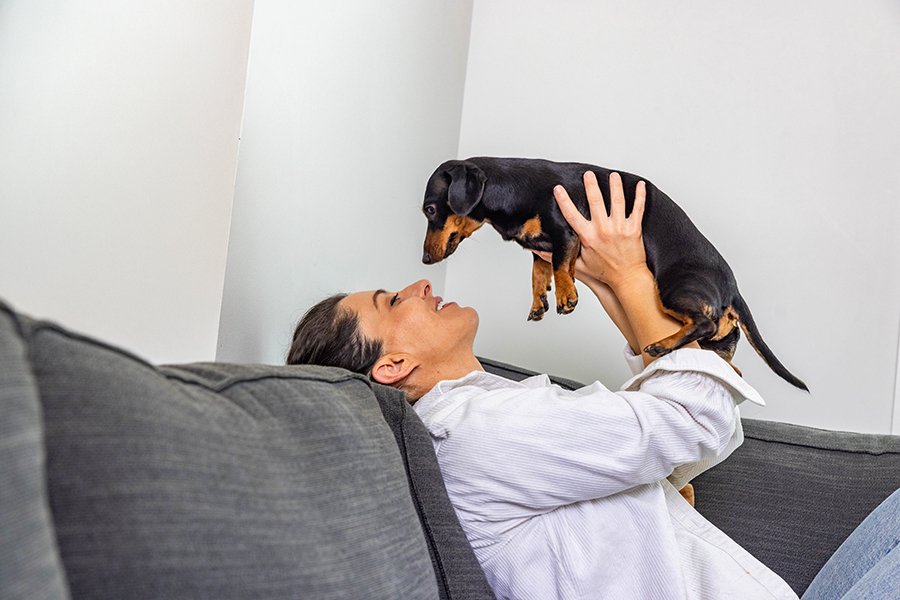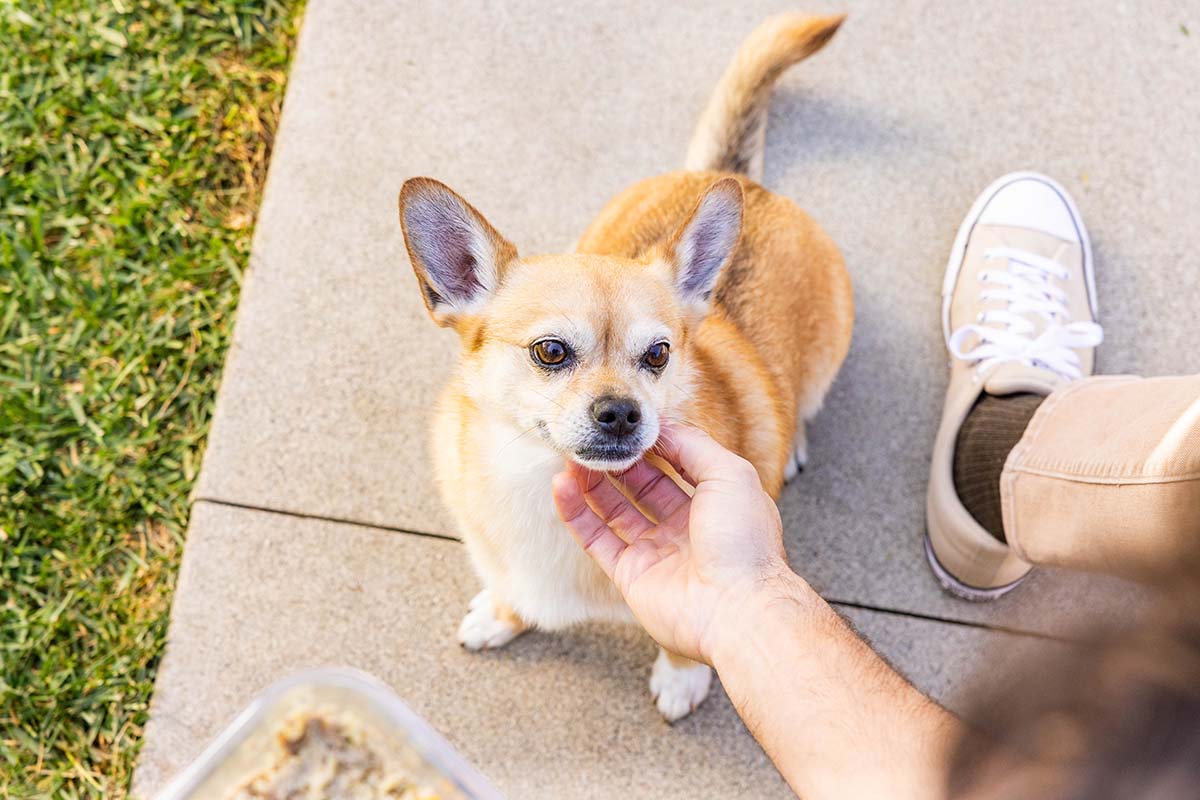Critical Signs of Stress in a Dog
Taking a look at the critical signs of stress in a dog and what loving pet parents can do to help their pooch overcome his anxiety.
If there’s one thing we’ve learned in the past several years, it’s how harmful stress can be to our health. We often turn to our furry friends when we feel stressed, and their unconditional love helps us feel better. But what about them?
Does your dog get stressed, and would you know if he did? Let’s take a look at the critical signs of stress in a dog and what loving pet parents can do to help their pooch overcome his anxiety.
Stress and Health

Stress is anything that creates feelings of physical or emotional pain or pressure. There are a number of different causes of stress, and the symptoms associated with stress are varied.
For dogs, loud noises are often a source of stress, as is separation from their beloved human family members. Many dogs are stressed by thunderstorms or other natural events, and some of the more subtle symptoms of their stress might go unnoticed by even the most loving pet owners.
If left unchecked, chronic stress can result in health problems that could affect your dog’s wellness throughout his life. Of course, underlying health issues can also cause your pooch added stress.
Like anything else, the first step to helping your furry buddy deal with stress is to recognize the signs of anxiety that indicate he needs your help. So, what are the signs of stress in dogs?
Critical Signs of Stress in a Dog

According to a recent study conducted by the School of Medicine at Virginia Commonwealth University, dogs demonstrate numerous behaviors to communicate stress, and the interpretation of those so-called ‘stress signals’ is vital to help improve your dog’s well-being effectively. Let’s examine these more closely:
Avoidance
When dogs are feeling uncertain about something, they may exhibit behaviors of avoidance. This might mean they look away from the source of the stress, but they might also lift a paw as if to keep it a bay, and they might start to press against their owner or handler.
Avoidance might also include hiding from you or other people or animals or attempting to escape. However, there are even more subtle signs of avoidance. These include sniffing or yawning frequently, types of signs that are easy to miss.
Fear
Perhaps one of the more obvious indicators of a dog’s stress levels is fear. If your pooch is frightened, you’ll notice stress signals like:
- flattening his ears
- lowering his head
- tucking his tail between his legs
- bracing of the hind legs
If the fear is not relieved, your dog may begin to display signs of aggression. Most of the time, you will recognize the signs of a dog feeling fear, but it’s good to catch it early on so that your pooch won’t feel trapped by whatever is frightening him.
Gaze
Your dog’s gaze is an important factor in canine communication. Remember that dogs are pack animals, and it’s common for them to seek information from other pack members. That means you.
When your best friend is stressed, he might direct his gaze toward you for reassurance and to gauge the nature of the situation. After all, if you’re scared, then he’ll know he should be scared too. If you’re not afraid, he’ll relax some. This is particularly true for dogs who have an insecure attachment style.
Freezing
If your pooch can’t avoid a perceived threatening situation, they might freeze to minimize visibility to what they feel is threatening them. If they freeze, they may adopt a posture that reduces their body size and protects vulnerable parts of their body.
When they freeze up, they often stop responding to environmental cues, including any commands you might be trying to give them. Freezing also frequently precedes overt aggression.
Aggression
Aggression is another common response to dog anxiety. As the saying goes, the best defense is a strong offense. While you might think you would easily spot aggressive behavior, some of the more subtle signs might go unnoticed.
Typical aggressive responses include:
- raised hackles
- a closed mouth
- an alert stance toward the target
- directed gaze
- tail stiffening
- growling
- barking
- snapping at the air
- lunging
- biting
Aggression can also demonstrate destructive behaviors. For example, dogs suffering from separation anxiety, a very common source of stress, may eat your couch or destroy other household items to communicate their feelings of distress.
Assent/Dissent
Dogs typically use body language and behavior to communicate their consent for interaction. If they want to interact with you or other people, they will typically approach a person presenting a nonthreatening posture and an open palm. If they remain motionless or move away, they are communicating dissent.
But many people don’t recognize those behaviors and may continue to move toward your pooch despite his dissent. A good practice for dog owners and handlers is to instruct others about the proper way to approach their furry friend.
What are the Physical Indicators of Stress in Dogs?

There are several physical signs your dog may give you to communicate stress. Here are a few things he might do:
- Pacing and shaking — When dogs are stressed, as they often are at the veterinarian’s, for example, they may shake their bodies vigorously, as they do after a bath. They may do the same thing after getting off the exam table. They might also pace around in a repeated path while waiting for the vet. These are typical stress indicators.
- Whining or barking or other vocalization — This is normal behavior for dog self-expression, but it may become downright panicked in stressful situations. They are trying to get your attention, or they are attempting to self-soothe.
- Yawning, drooling, and lip licking — When dogs are tired or bored, they yawn just like humans do. But they also yawn when stressed. A stress yawn is more prolonged and intense than a yawn associated with sleepiness. You might also see them drooling—think of their first car ride, for example—or lip licking to indicate they are nervous.
- Watch the eyes and ears — Stressed dogs, just like stressed people, experience physiological changes when stressed in preparation for fighting or fleeing from the source of their anxiety. Their eyes dilate, they blink rapidly, and they may open their eyes more widely, which will show more of the whites of their eyes (also called “whale eye”). Their ears may go from being relaxed to alert or even pinned back against their head.
- Body posture — A healthy dog with no physical impairments who shifts his weight to his rear legs or cowers is showing critical signs of stress. He might also tuck his tail between his legs or become rigid and frozen.
- Shedding — Nervous show dogs do what is colloquially known as ‘blowing their coat.’ That means they significantly increase their shedding as a sign of being anxious. It’s something pet parents might not notice in outdoor settings like the dog park, but if you do see it, it indicates your pooch is stressed.
- Panting — Panting is one way that dogs can cool off after exercise or when excited. But it can also indicate stress, particularly if your buddy is panting excessively even though he hasn’t been exercising or excited.
- Urinating or defecating— As part of the fight-or-flight response, animals may empty their bowels and bladders to prepare for what may come. This is not something they can necessarily control since it’s the body’s way of preparing itself for a physical response. Additionally, your dog might experience a loss of appetite when in a stressful situation.
How Can You Help Your Dog Alleviate His Anxiety?
The first thing to do when you see your dog stressed is to remove the stressor. Then, find a quiet place where you can help your pooch regroup and calm down.
You then want to comfort him but don’t overdo it. You can give him some dog treats, but make him first perform some kind of activity to receive that reward. Responding to familiar commands can help to distract him and give him a feeling of normalcy.
If your dog experiences chronic stress or is easily stressed, talk to a veterinarian to ensure your dog’s behavior is not the result of a medical problem. You might also consult with a veterinary behaviorist to evaluate the stress-related issues. They can make recommendations for the best way to proceed, such as dog training or even medications.
Make sure your dog is getting adequate exercise to help release tension. It’s also a good idea to establish a safe space in your home where your pooch can feel secure. Finally, it’s important to recognize that stress does serve a function.
Stress prompts your dog to avoid a potentially dangerous situation. In that way, it can be a protective type of behavior. But when the response is overly intense or prolonged, it can create bigger problems than it solves.
Why Should Pet Parents Learn to Recognize Dog Stress Responses?

Studies indicate that, while many people can identify the more obvious stress signals, they rarely notice the more subtle indicators. This includes turning their head away, yawning, and lip licking or nose licking. By failing to notice those subtle signs, they are unable to intervene in the early stages of stress.
In many cases, they underestimated their dog’s fearfulness and even responded with amusement. They rarely became concerned about their dog’s welfare. This indicates a greater need to educate dog owners so that they can more accurately interpret their dog’s body language and stress behavior.
Doing so can help prevent the development of anxiety-related health problems. They can take the appropriate steps to comfort their best friend and help him live a longer, healthier life.
Does Dog Food Play a Role in Stress?
Evidence supports the idea that diet plays a role in dog stress and their behaviors. Overcooked food may increase the level of bodily inflammation as well as the presence of medical conditions that can increase stress levels.
Modifying your dog’s diet may help to reduce his stress level. Oxidative stress, created by a physical or emotional stress response in your dog, can result in health problems, including cardiovascular disease, gastrointestinal problems, immune system dysfunction, and abnormal behaviors.
By regulating your dog’s intake of dietary elements like antioxidants and probiotics and avoiding overcooked food, you can help relieve your dog’s stress levels. Additionally, certain foods containing elements like B vitamins and tryptophan can help alleviate a dog’s stress.
Additionally, gently cooked food may help prevent the physiological responses that result in stress-related physical and behavioral problems. A lower-stress life will be a happier one for both you and your beloved canine buddy!
This content is for informational use only and does not replace professional nutrition and/or medical advice, diagnosis, or treatment. It is not a substitute for and should not be relied upon for specific nutrition and/or medical recommendations. Please talk with your veterinarian about any questions or concerns.
Townsend, Lisa, and Nancy R. Gee. 2021. “Recognizing and Mitigating Canine Stress during Animal Assisted Interventions.” Veterinary Sciences 8 (11): 254. https://doi.org/10.3390/vetsci8110254.
Konok, V., A. Marx, and T. Faragó. 2019. “Attachment Styles in Dogs and Their Relationship with Separation-Related Disorder – a Questionnaire Based Clustering.” Applied Animal Behaviour Science 213 (April): 81–90. https://doi.org/10.1016/j.applanim.2019.02.014.
Fan, Zhicong, Zhaowei Bian, Hongcan Huang, Tingting Liu, Ruiti Ren, Xiaomin Chen, Xiaohe Zhang, Yingjia Wang, Baichuan Deng, and Lingna Zhang. 2023. “Dietary Strategies for Relieving Stress in Pet Dogs and Cats.” Antioxidants 12 (3): 545. https://doi.org/10.3390/antiox12030545.
Grigg, Emma K., Juliann Chou, Emily Parker, Anwyn Gatesy-Davis, Sara T. Clarkson, and Lynette A. Hart. 2021. “Stress-Related Behaviors in Companion Dogs Exposed to Common Household Noises, and Owners’ Interpretations of Their Dogs’ Behaviors.” Frontiers in Veterinary Science 8 (November). https://doi.org/10.3389/fvets.2021.760845.
Mariti, Chiara, Angelo Gazzano, Jane Lansdown Moore, Paolo Baragli, Laura Chelli, and Claudio Sighieri. 2012. “Perception of Dogs’ Stress by Their Owners.” Journal of Veterinary Behavior 7 (4): 213–19. https://doi.org/10.1016/j.jveb.2011.09.004.
Weir, Malcolm, and Lynn Buzhardt. 2009. “Signs Your Dog Is Stressed and How to Relieve It.” Vca_corporate. 2009. https://vcahospitals.com/know-your-pet/signs-your-dog-is-stressed-and-how-to-relieve-it.








